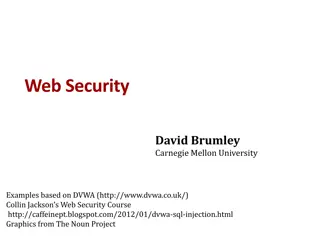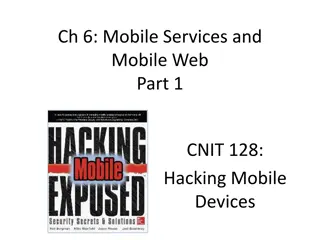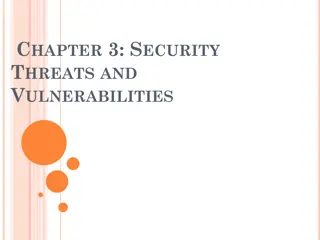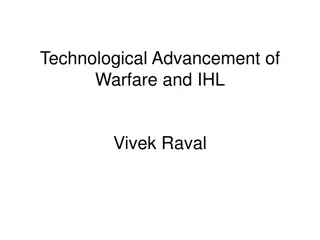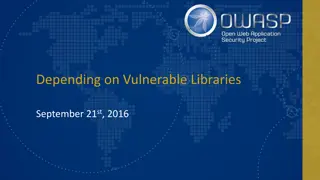Understanding Web Application Vulnerabilities in Information Warfare
Web application vulnerabilities such as Cross-Site Scripting, SQL Injection, and Broken Authentication pose significant risks in information warfare. Current solutions include Black-Box Security Testing and XSS Analyzers, but they have limitations like static verification and dependence on security experts. Improving detection methods and reducing false positives are crucial in safeguarding against high-risk vulnerabilities.
Uploaded on Oct 02, 2024 | 0 Views
Download Presentation

Please find below an Image/Link to download the presentation.
The content on the website is provided AS IS for your information and personal use only. It may not be sold, licensed, or shared on other websites without obtaining consent from the author. Download presentation by click this link. If you encounter any issues during the download, it is possible that the publisher has removed the file from their server.
E N D
Presentation Transcript
Role of Web Application Vulnerabilities in Information Warfare Aditya Tripathi Mohan Krishna Karanam Siva Prasad Reddy Nooli Srinivas Balivada Srinivas Burra Yugendhar Reddy Sarabudla
Problem Overview Current Problems : 1) Cross-Site scripting (XSS) 2) Cross-Site Request Forgery (XSRF) 3) SQL injection 4) Broken Authentication and Session Management 5) Insufficient TLS binding 6) Insecure Cryptographic storage
Problem Overview zXZX Web Application Security Consortium (WASC) reports: 12,186 real-world websites list a total of 97,554 vulnerabilities 49% of these websites contain high-risk vulnerabilities
Problem Overview - Current Solutions Black-Box Security Testing Methodology XSS Analyzer
Limitations of Current Solution 1) Static Verification 2) Manual Intervention to Dynamic Tools 3) May provide False positives 4) Dependence on security experts
Limitations of Current Solution Static Verification : Tools deployed as plugins on the browser Predefined payload on input points targeting unsanitized HTML Elements
Limitations of Current Solution Manual Intervention : Hand Picked Payload while performing server side scan No Knowledge on Server side detection
Limitations of Current Solution False Positives :
Limitations of Current Solution Dependence on Security Experts : Synthesizing of effective payload - Based on common cases of broken(or partial) input sanitization or validation
Specific Technical Limitations Limited Scope - Main source code is out of static tool reachability. No Detection of Logical Flaws - Cannot detect logical flaws in the code. Processing cost- Processing cost is huge for huge data. Lack of Learning Capabilities- No Self-learning. No detection of Server MisConfiguration-Critical security configurations can be missed.
Specific Technical Limitations Limited Scope : No access to server-side code Black-box model of scanning Only client side learning knowledge
Specific Technical Limitations No Detection of Logical Flaws : Missing logical code Invalid logic in the code Misinterpretation of use case
Specific Technical Limitations Lack of Learning Capabilities : Cannot use the previous experiences on server code Leverages problem on stored vulnerabilities
Specific Technical Limitations No Detection of Server Misconfiguration : Only on the browser Uses load testing with payload on HTML elements No knowledge on Server side configuration
Proposed Solution Dynamic scanning Server side scan Detection of logical flaws Self learning capabilities Detection of server misconfiguration More of white box testing Learn from previous learning experience
How will we implement ? The idea of XSS analyser in the case of testing reusability Advanced machine learning techniques for self learning Uses version control for bug fixes Taint analysis for detecting false positives 1. Taint analysis 2. Data Mining 3. Code Correction 4. Feedback 5. Testing
How feasible is it? Suitable for specific scripting lang. Tools with these ideas , taint analysis has shown some significant results. Easy to migrate to new programming languages.
Conclusion It is important to detect vulnerabilities before the application is deployed into production. Adopting a learning approach to identify vulnerabilities can increase efficiency of the scanners.
References [1] Omer Tripp, Omer Weisman, Lotem Guy. (2013). Finding your way in the testing jungle: A learning approach to web security testing. In Proceedings of the 2013 International Symposium on Software Testing and Analysis (ISSTA 2013). [2] OWASP Top Ten Project, https://www.owasp.org/index.php/Top_10_2010- A1 [3] R. S. Sutton and A. G. Barto. Introduction to Reinforcement Learning. MIT Press, Cambridge, MA, USA, 1st edition, 1998. [4] Ib ria Medeiros, Nuno Neves (2013).Detecting and Removing Web Application Vulnerabilities with Static Analysis and Data Mining.








